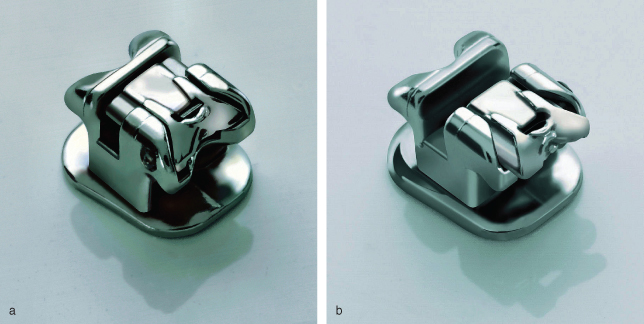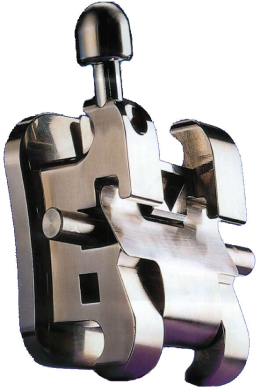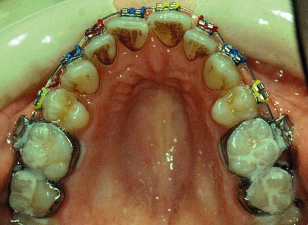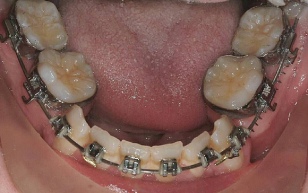32
Self-ligating brackets
INTRODUCTION
Self-ligating brackets have an inbuilt labial face which can be opened and closed to retain and release engagement of the archwire. This labial face is usually metal but can be ceramic or plastic resin and is usually referred to as a clip or slide. Brackets incorporating their own ligation system have existed for a surprisingly long time in orthodontics but they have made a major impact in orthodontics only in the past decade. New designs continue to appear, with at least 20 new brackets since 2000. Several earlier designs had deficiencies, for example the clips or slides were too awkward to open and close or were prone to distortion or fracture or to inadvertent opening between visits. There are now some excellent self-ligating brackets available. Two popular and representative brackets are the Damon MX (Figure 32.1) and the In-Ovation (Figure 32.2). The author has a fairly wide range of experience of self-ligation, having used 15 types of such bracket since 1982 with exclusive use of self-ligating brackets since 1995. Claims for the advantages for such brackets have ranged from the straightforward to the more surprising. A straightforward and easily tested claim is that these brackets are quicker to use than conventional ligation. A more thought-provoking and challenging claim is that self-ligation enables the low forces from the lips to influence the direction and extent of tooth movement during alignment. This chapter aims to briefly examine these claims and summarise the current and probable future place of self-ligation.
Figure 32.1a,b The Ormco Damon MX is a popular passive self-ligating bracket.

Figure 32.2 The GAC IN-Ovation bracket is a popular active self-ligating bracket. The flexible clip intrudes into the slot, decreasing its labiolingual dimension.

THE DEFICIENCIES OF CONVENTIONAL LIGATION
Conventional wire or elastomeric ligatures have significant failings. Wire ligatures are usually secure and robust but are very slow to place and remove. Studies1,2 have shown that wire ligation is very slow compared to elastomerics with the use of wire ligatures adding almost 12 minutes to the time needed to remove and replace two archwires. This difference in speed of use is the largest and very understandable reason why so few wire ligatures are now used. Elastomeric ligatures, while being much more rapid to place, have two inherent deficiencies, inadequate ligating performance and high friction. The force they provide decays with time and this can lead to loss of full archwire engagement and consequent loss of tooth alignment. The force decay of elastomerics has been well documented.3,4 Figure 32.3 shows failure of elastomeric rings to achieve full archwire engagement and Figure 32.4 shows loss of control by elastomeric ligatures later in treatment. Elastomeric ligatures also have a high coefficient of friction, which inhibits the majority of desired tooth movements. Looking at other potential deficiencies, there is some reason to believe that elastomeric ligatures inhibit good oral hygiene, while the ends of wire ligatures can traumatise the oral mucosa.
Figure 32.3 Failure of elastomeric ligatures to fully engage a 0.014 inch aligning wire on several brackets.

Figure 32.4 Failure of elastomerics ligatures to maintain full engagement on three of the six ligated teeth. This necessitated a backward step in treatment.

CORE ADVANTAGES OF SELF-LIGATION
In the past two decades, a consensus has emerged on the potential core advantages of self-ligation. These address all the deficiencies of conventional ligation:
- More certain full archwire engagement
- Faster archwire removal and ligation
- Low friction between bracket and archwire
- Less chairside assistance required
- Better oral hygiene.
Self-ligating brackets vary in their capacity to reliably deliver these potential core advantages, but the best deliver on all of them. The first three advantages in the list can be considered proved beyond reasonable doubt, the fourth is self-evident since no passing to and fro of ligatures is required and the last core advantage on the list is a tenable hypothesis but is not yet proven.
Secure, Full Archwire Engagement and Low Friction
A self-ligating clip or slide achieves and maintains full archwire engagement. The friction between bracket and archwire has been clearly demonstrated and quantified in many studies to be much lower with self-ligation than with elastomerics.2,5,6 This combination of very low friction and very secure full archwire engagement is currently only possible with s/>
Stay updated, free dental videos. Join our Telegram channel

VIDEdental - Online dental courses


